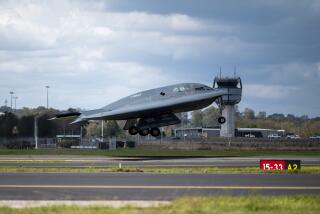McManus: Doubts about drones
When President Obama came to office in 2009, it didn’t take his new administration long to settle on a favorite anti-terrorist tactic: drone strikes. In his first three years in office, the number of drone strikes against targets in Pakistan and Yemen increased dramatically, from 35 in 2008 to 121 in 2010, before dropping back to 79 so far this year, according to the Long War Journal, a website that has attempted to keep track of reported strikes.
The number of people killed by the strikes — Al Qaeda terrorists but also local militants and, inevitably, some civilians — escalated too; estimates vary widely, but at least 3,000 have died in both countries combined.
And that has led to second thoughts, not principally for ethical reasons (officials say they have always tried to minimize civilian casualties) but for practical ones. Drone strikes are undeniably effective at eliminating terrorists. But too many drone strikes can also provoke a political backlash, recruiting as many terrorists as they kill.
Increasingly, that critique is coming not only from human rights organizations or cautious diplomats at the State Department but from veterans of the secret war against terrorism.
“We’ve crossed a line … from using drones against known terrorists to using them more broadly against whole groups of militants,” Robert L. Grenier, a former CIA station chief in Pakistan, told me last week. “It plays into the narrative that portrays the United States as an enemy of Islam.”
In fact, a Pew Research Center survey found that the percentage of Pakistanis who viewed the United States as a friendly country has dropped since Obama took office, from 19% in 2008 to 12% this year.
In Yemen, where U.S. drone strikes have killed dozens of suspected terrorists, the local affiliate of Al Qaeda has grown, not diminished. “We’re in danger of creating more enemies than we are removing,” Grenier said.
Grenier is not alone. Henry A. Crumpton, who spurred the development of the first armed drones as the CIA’s counterterrorism chief, has said he fears the agency has fallen into an “overreliance on technology,” opting for short-term gains from drone strikes at the expense of the long-term payoff that human intelligence efforts can bring.
Inside the administration, some officials have been arguing for stricter limits on drone operations, especially to curb what are known as “signature strikes” — strikes against guerrillas in Pakistan or Yemen who appear to be members of Al Qaeda affiliates but who have not been identified individually.
There are even signs that some new limits have been imposed with no public announcement. In Somalia, for example, the United States has carried out no drone strikes against the Al Shabab militia since February, reportedly because the Pentagon’s general counsel ruled that the guerrillas, while undeniably a menace to the local government, posed no direct threat to the United States.
But it will be difficult to disentangle the United States and its drones from the internal conflicts of Yemen, where the administration is backing a fragile government against a local Al Qaeda offshoot, or Pakistan, where the military supports U.S. strikes against its enemies but opposes strikes against extremists it considers friendly.
On those battlegrounds, argues Micah Zenko of the Council on Foreign Relations, “our drones have become the counterinsurgency air force for those governments.”
“The real reason for most of these strikes has been to protect a regime in Pakistan or Yemen,” Zenko said.
Nobody contests the right of the United States to strike at terrorists who pose an imminent danger to U.S. citizens. But when the United States secretly uses armed force in another country’s internal conflict, “it sets a dangerous precedent,” he said.
Is the Obama administration listening? It can be hard to tell, since most of the drone program is shrouded in secrecy.
But in recent statements, administration officials from Obama on down have emphasized the importance of limiting the drone strikes. “Our goal has been to focus on Al Qaeda and to focus narrowly on those who would pose an imminent threat to the United States,” Obama said in a television interview in September.
“It’s not some random effort, not some unnecessarily broad effort, but a very targeted effort,” Obama’s national security advisor, Thomas Donilon, said last week .
So far, Zenko and other critics say, the administration’s practice doesn’t fully match its aspirations.
But in a little-noticed remark, Obama proposed that Congress replace its hastily drafted Authorization for Use of Military Force passed in the aftermath of 9/11.
“One of the things we’ve got to do is put a legal architecture in place — and we need congressional help in order to do that — to make sure that not only am I reined in, but any president’s reined in,” Obama said on Oct. 16 on, of all places, comedian Jon Stewart’s “The Daily Show.”
Congress has shown no great appetite to legislate the war on terror. Members may not relish the idea of explaining to constituents why politicians should place any limits on the use of armed force against terrorists. But reining in drones — holding them to their original use against terrorists who pose an imminent threat to the United States — would be a good idea.
Follow Doyle McManus on Twitter @DoyleMcManus
More to Read
A cure for the common opinion
Get thought-provoking perspectives with our weekly newsletter.
You may occasionally receive promotional content from the Los Angeles Times.











